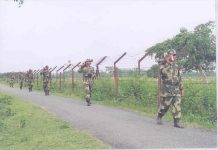The oddly wiry Pied Cuckoo or Chatak, held by folklore to herald the arrival of the monsoon, is one of the latter. “It turns out that legend is largely right,” says Quader. From the 584 records they have obtained for the bird, it appears that in places where the monsoon arrives early, this African migrant always arrives immediately before; and in the northern and northwestern parts of the country, where the monsoon arrives late, it arrives nearly a month before it.
Why this happens is still being debated. Quader suspects that the Pied Cuckoo actually uses the high-altitude jet streams that bring the monsoon from Africa to India to make its oceanic journey. It heralds the monsoons, because it comes with it! Once on land, however, it no longer needs the support of the monsoon winds, and so outpaces them.
In the case of the Rosy Starling, a gregarious migrant from Europe, Migrant- Watch’s birders have gathered 619 observations. They indicate that this bird, gigantic flocks of which can often be seen perched on the branches of trees around dusk, arrives in northwestern India in the latter part of July. After that it is found lingering in Gujarat and Rajasthan, before appearing in the southernmost parts of India three months later.
The movement of the Grey Wagtail, probably the most common winter migrant, has also been pinned down. It seems that this bird, conspicuous because of its habit of perching on exposed branches, arrives in late August and leaves in early May.
The Greenish Warbler, whose chuckling, trilling song is heard more than the bird is seen, arrives a week or so later and departs around the same time.
“We have got a decent baseline for these four species,” says Quader. “We will need many more observations before we can detect a 10 percent change in their patterns, but now we can detect and establish any major differences.”
ONE OF MigrantWatch’s biggest achievements has been that it has made amateur birdwatchers more scientific, thinks Quader. They are realising the importance of systematically recording their observations, and there’s an increasing willingness to share and compare data. That, Quader says, “is an important cultural change”.
The programme’s web-based platform makes it easy for participants to contribute observations. Shivaprakash praises it for being very user-friendly. For Singal, the fact that it allows him to see and analyse the data others have reported is a major draw.
Happy as he is about to the progress MigrantWatch has made, Quader is realistic. He knows this is just a start. “There are large swathes of the country, especially in the east and the northeast, from where we have little data,” he confesses.
For comparison, he points to eBird, run by the Cornell Lab of Ornithology and National Audubon Society in the US to monitor North American birds. In March 2012 alone, it got over 3.1 million bird observations.
When Quader met the head of eBird recently, they got talking about a possible partnership. “It will take us another five years of observations to set the stage for something like that,” he says matter-of- factly.
Ornithologists like Rahmani are impressed with what MigrantWatch has achieved so far. Especially, given the complexities of establishing a baseline in a country as geographically varied as India, with little financial support for the task. “In the long run, it will be able to give us valuable information about the effect of climate change on our birds,” he says.
MigrantWatch’s success prompted BNHS to try something similar for sparrows last year. Citizen Sparrow, done in collaboration with the Ministry of Environment and Forests and NCBS, got 10,000 observations from more than 8,000 locations in India in the span of a few months. According to Rahmani, the data is currently being analysed, and will be released in two months.
Is this where MigrantWatch’s citizen scientists imagined they would be in five years? “When we started out, we had no idea of what to expect,” laughs Quader, “but looking back, I don’t think we could have expected more.”
akshai@tehelka.com












